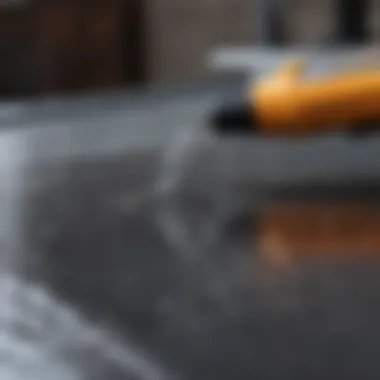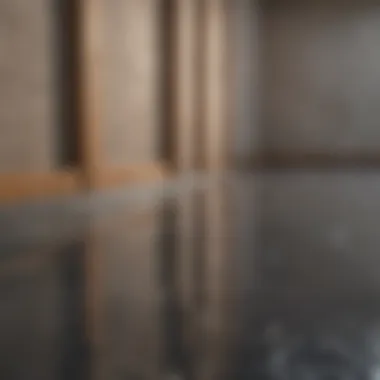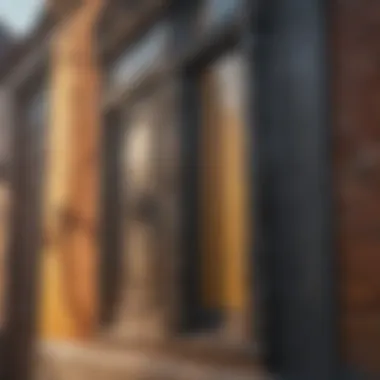Unlocking the Secrets: The Ultimate Guide to Top Waterproofing Techniques


Overview of Waterproofing Methods
Waterproofing is a crucial aspect of the home improvement industry, aiming to protect structures from potential water damage and moisture infiltration. A robust waterproofing system not only enhances the longevity of buildings but also ensures structural integrity. Understanding the best waterproofing methods is paramount for homeowners and house owners alike as it shields their investments from deterioration and costly repairs.
Common Issues and Solutions
Amidst the realm of waterproofing, homeowners often face daunting challenges such as water seepage, leakage, and mold growth. These issues not only compromise the aesthetics of a property but also pose health risks and structural concerns. By implementing proper drainage systems, employing quality sealants, and conducting regular inspections, individuals can mitigate these common challenges effectively. Simple maintenance routines like gutter cleaning and crack repairs can prevent water intrusion and safeguard the property against extensive damage.
Product Recommendations
When considering waterproofing solutions, gaining insight into reputable industry brands like Aquaguard, Berger, and Dr. Fixit is essential. These brands offer a diverse range of products, from premium sealants to durable membranes, tailored to provide optimal protection against water intrusion. Aquaguard's innovative sealants boast superior adhesion properties, ensuring long-lasting waterproofing performance. Berger's reliable membranes offer seamless coverage and UV resistance, making them ideal for outdoor applications. Dr. Fixit's comprehensive waterproofing solutions cater to various surfaces, from concrete to metal, guaranteeing comprehensive protection.
Step-by-Step Guides
To initiate a successful waterproofing project, meticulous planning and execution are imperative. Start by assessing the property for potential vulnerabilities and identifying areas prone to water ingress. Thoroughly clean and prepare the surfaces before applying waterproofing products to ensure maximum adhesion and effectiveness. Utilize high-quality tools and materials during the application process, following manufacturer guidelines for optimal results. Regular maintenance checks and timely repairs are crucial to preserving the integrity of the waterproofing system and prolonging its efficacy.
Stay tuned for detailed insights on specific waterproofing methods, expert tips for overcoming common challenges, and in-depth product reviews to assist you in implementing effective solutions for your property's waterproofing needs.
Introduction
Waterproofing is a critical aspect of construction and infrastructure maintenance, essential in protecting buildings from water damage and ensuring their longevity. This article delves into a comprehensive guide on the best methods for waterproofing, covering a range of techniques from sealants to membranes. By understanding the importance of waterproofing, individuals can safeguard their structures effectively against moisture infiltration and potential structural issues.
Understanding the Importance of Waterproofing
Preventing Water Damage
Water damage is a formidable threat to constructions, leading to costly repairs and compromises in structural integrity. Effective waterproofing methods, such as silicone sealants and bituminous membranes, play a pivotal role in preventing water ingress and preserving the condition of buildings. The key characteristic of preventing water damage lies in its proactive approach to mitigating potential risks, offering a durable solution to moisture-related issues. By investing in high-quality waterproofing materials and techniques, individuals can protect their properties from the damaging effects of water infiltration.
Enhancing Structural Durability
Enhancing structural durability through waterproofing measures is crucial for ensuring the long-term stability of buildings. By utilizing products like polyurethane sealants and EPDM membranes, structural elements can be shielded from external moisture, extending their lifespan and reducing maintenance requirements. The unique feature of enhancing structural durability is its ability to fortify building components against environmental hazards, reinforcing their strength and resilience. While there may be initial costs associated with robust waterproofing, the long-term benefits of enhanced structural durability far outweigh any drawbacks, making it a worthwhile investment.


Common Issues Due to Poor Waterproofing
Mold and Mildew Growth
Poor waterproofing practices often lead to mold and mildew infestations, posing health risks and causing unsightly damage to surfaces. Mold and mildew growth thrive in moist environments, highlighting the importance of effective waterproofing in mold prevention. By addressing moisture ingress with proper sealing and membrane installations, individuals can mitigate the risks of mold proliferation and maintain a healthy indoor environment. The disadvantage of neglecting mold prevention through waterproofing can result in extensive remediation efforts and compromised indoor air quality.
Structural Deteriotation
Structural deterioration due to poor waterproofing is a pressing concern for building owners, as water infiltration can weaken building foundations and components over time. The key characteristic of structural deterioration attributed to inadequate waterproofing is the gradual decay of construction materials, leading to compromised structural integrity. To counteract this issue, investing in quality waterproofing membranes and repair solutions is essential for preserving the longevity of buildings. The advantage of addressing structural deterioration through effective waterproofing is the prevention of costly structural repairs and extensive damage caused by water seepage.
Types of Waterproofing Materials
Understanding the significance of the category of Types of Waterproofing Materials within The Inclusive Handbook towards Top Waterproofing Systems is pivotal. Covering a plethora of materials ranging from sealants to membranes, this section sheds light on the foundation of effective waterproofing methodologies. With an emphasis on the distinct characteristics, benefits, and considerations associated with different Types of Waterproofing Materials, readers are equipped with a nuanced understanding of how to select the most suitable option for their specific requirements.
Sealants
When discussing sealants, it's imperative to delve into the specifics of Silicone Sealants and Polyurethane Sealants to grasp their individual contributions towards the overall objective of waterproofing. Let's first focus on Silicone Sealants and dissect their key attributes that render them a popular choice in the realm of waterproofing. Despite challenges, Silicone Sealants offer exceptional durability and flexibility, making them a reliable option for sealing various surfaces. While their resistance to weathering is commendable, their application can be labor-intensive.
Moving on to Polyurethane Sealants, these sealants are known for their exceptional adhesion properties, making them a favored choice for demanding waterproofing tasks. Their elasticity allows for structural movements without compromising the seal. Although highly effective, Polyurethane Sealants may require special precautions during application due to their chemical composition.
Waterproofing Membranes
Exploring the realm of Waterproofing Membranes reveals intriguing insights into Bituminous Membranes and EPDM Membranes. Beginning with Bituminous Membranes, these membranes exhibit remarkable waterproofing capabilities, owing to their composition of bitumen and reinforcements. With excellent flexibility and resistance to UV radiation, Bituminous Membranes are an ideal choice for diverse applications, including roofs and basements. However, their installation process can be complex and laborious.
Transitioning to EPDM Membranes, their superior durability and weather resistance set them apart in the waterproofing landscape. EPDM Membranes offer seamless protection against water intrusion, especially in areas prone to extreme weather conditions or mechanical stress. Despite their exceptional performance, EPDM Membranes may require specialized knowledge for correct installation, adding complexity to the waterproofing process.
Cementitious Waterproofing
The realm of Cementitious Waterproofing encompasses Integral Crystalline Waterproofing and Acrylic-based Waterproofing, each presenting unique characteristics and considerations. First, Integral Crystalline Waterproofing introduces a revolutionary approach by utilizing crystalline agents within concrete structures to enhance waterproofing capabilities. This proactive method ensures long-term protection by self-healing cracks, making it a preferred choice for critical infrastructure projects. However, the initial cost can be higher compared to traditional methods.
Shifting focus to Acrylic-based Waterproofing, this solution offers a versatile and cost-effective means of waterproofing various surfaces. Acrylic-based Waterproofing forms a protective coating that is resistant to UV radiation, ensuring prolonged durability. While easy to apply and maintain, Acrylic-based Waterproofing may necessitate periodic reapplication to sustain its efficacy over time.


Factors to Consider Before Choosing a Waterproofing Method
When considering the right waterproofing method for any structure, several crucial factors must be taken into account. From the geographical location to the specific climate conditions, each element plays a vital role in determining the most effective solution. One of the primary considerations is how different locations and climates impact the performance and longevity of waterproofing materials. Factors such as high humidity levels and extreme temperature variations can significantly affect the effectiveness of the chosen method. It is essential to carefully assess the unique requirements of each project to ensure the selected waterproofing approach meets the specific demands of the environment.
Location and Climate
Impact of Humidity
Humidity levels in a given area can have a profound impact on the effectiveness of waterproofing methods. High humidity creates a conducive environment for mold and mildew growth, posing a serious threat to the structural integrity of buildings. Waterproofing materials must be selected based on their ability to withstand the challenges presented by humid conditions. Additionally, humidity can accelerate the deterioration of certain construction materials, underscoring the importance of choosing appropriate waterproofing solutions that offer optimal protection against moisture infiltration.
Temperature Variations
Temperature fluctuations can also influence the performance of waterproofing systems. Extreme variations in temperature can cause expansion and contraction in building materials, leading to cracks and vulnerabilities in the structure. Understanding how temperature changes affect the overall stability of a building is essential when selecting a waterproofing method. Effective waterproofing solutions should be able to withstand these fluctuations and maintain their integrity over time, ensuring long-lasting protection against water damage.
Type of Structure
Residential Buildings
Residential structures have distinct waterproofing requirements due to the presence of living spaces and occupants. Maintaining a comfortable and safe indoor environment is paramount in residential buildings, making water intrusion a significant concern. Waterproofing methods for residential buildings focus on preventing water leaks, mold growth, and structural decay to safeguard the well-being of residents. Choosing the right waterproofing approach for residential properties is essential to ensure the durability and longevity of the structure.
Commercial Structures
Commercial buildings, on the other hand, often have unique waterproofing needs dictated by their intended use and occupancy. Waterproofing solutions for commercial structures must account for factors such as foot traffic, heavy loads, and specific industry regulations. Dependable waterproofing methods are crucial for protecting valuable assets, ensuring business continuity, and meeting safety standards. Tailoring waterproofing strategies to suit the demands of commercial constructions is vital in maintaining a secure and functional built environment.
Budget and Longevity
Initial Cost vs. Maintenance Expenses
Balancing the initial cost of waterproofing installation with long-term maintenance expenses is a critical consideration for property owners. While some waterproofing methods may have a higher upfront investment, they can offer enhanced durability and lower maintenance costs over time. Conversely, opting for cheaper solutions without considering long-term maintenance requirements can result in higher expenses and structural issues in the future. Understanding the financial implications of different waterproofing options and weighing them against their longevity is essential in making informed decisions that prioritize both cost-effectiveness and performance.
Best Practices for Effective Waterproofing


In this comprehensive guide to the best waterproofing methods, understanding the importance of proper waterproofing practices is paramount. Ensuring that your structures are effectively protected against water damage involves a multifaceted approach. One of the key elements in effective waterproofing is proper surface preparation. Before applying any waterproofing materials, cleaning and smoothing surfaces play a crucial role. This meticulous process involves removing any dirt, debris, or imperfections on the surface to create a suitable base for waterproofing application. By undertaking thorough cleaning and smoothing, you enhance the adhesion and performance of the waterproofing materials, ultimately prolonging the longevity of your structures.
Proper Surface Preparation
Cleaning and Smoothing Surfaces: When it comes to the cleaning and smoothing of surfaces, attention to detail is indispensable. By meticulously preparing surfaces through thorough cleaning, you create an optimal foundation for waterproofing applications. The key characteristic of this step lies in its ability to eliminate any potential barriers that could impede the proper adhesion of waterproofing materials. This meticulous process ensures that the waterproofing solution can bond effectively to the surface, enhancing its durability and performance. While time-consuming, the advantages of investing in comprehensive surface preparation far outweigh any potential disadvantages in this article.
Repairing Cracks and Gaps: Addressing cracks and gaps in structures is another crucial aspect of proper surface preparation for effective waterproofing. By repairing any imperfections in the surfaces, you prevent moisture infiltration that can lead to water damage and structural issues. The key characteristic of repairing cracks and gaps is its ability to fortify the structural integrity of the surfaces, creating a seamless barrier against water intrusion. This meticulous step ensures that the waterproofing method applied is not compromised by underlying structural weaknesses. While it may require additional time and resources, the benefits of thorough crack and gap repair significantly outweigh any drawbacks in this context.
Application Techniques
Proper application techniques are vital in ensuring the effectiveness of waterproofing methods. Two key methods, namely spray application and rolling and brushing, offer distinct advantages in safeguarding structures against water damage.
Spray Application: The spray application method delivers a uniform coating of waterproofing material, ensuring comprehensive coverage and protection. Its key characteristic lies in its ability to reach inaccessible or intricate surfaces with ease, providing a seamless waterproofing layer. The unique feature of spray application is its efficiency in large-scale projects, where speed and accuracy are essential. While it offers quick application and coverage, potential drawbacks may include overspray issues and the need for proper ventilation during application.
Rolling and Brushing Methods: Alternatively, rolling and brushing methods offer a hands-on approach to waterproofing application. These techniques allow for precise control over the thickness and distribution of the waterproofing material. The key characteristic of rolling and brushing methods is their suitability for smaller, detailed areas that may require individual attention. The unique feature of these methods is the ability to customize the application based on specific structural requirements, ensuring thorough protection against water infiltration. While these methods provide precision and flexibility, meticulous attention to detail is essential to avoid uneven application or missed spots.
Maintenance Tips for Longevity
In addition to proper surface preparation and application techniques, regular maintenance is crucial for maximizing the longevity of waterproofing solutions. Implementing routine inspections and timely repairs can significantly prolong the effectiveness of the waterproofing methods applied.
Regular Inspections: Conducting regular inspections allows you to identify any early signs of damage or wear on the waterproofing layer. The key characteristic of regular inspections is their proactive nature, enabling you to address potential issues before they escalate. This diligent practice ensures that any compromised areas are promptly repaired, maintaining the integrity of the waterproofing system. While inspections require time and attention to detail, the benefits of early damage detection and prevention outweigh any potential drawbacks.
Timely Repairs: Upon identifying any issues during inspections, prompt repairs are essential to prevent further water damage. Timely repairs address any compromised areas before they worsen, preserving the structural integrity of the waterproofing system. The key characteristic of timely repairs is their preventive nature, mitigating the risk of water infiltration and structural deterioration. By promptly addressing any damages or vulnerabilities, you ensure the long-term effectiveness of the waterproofing method employed. While repairs may necessitate immediate action and resources, the proactive approach taken significantly outweighs the consequences of delayed or neglected repairs.
Conclusion
The Conclusion section of this article serves as a crystallization of the critical aspects discussed throughout. Waterproofing is not just about preventing water damage or enhancing structural durability; it is a proactive measure that significantly impacts the longevity and integrity of any construction project. By meticulously selecting the appropriate waterproofing method and investing in quality materials, individuals can safeguard their structures against the relentless assault of moisture and potential devastation. It is imperative to acknowledge that a well-executed waterproofing strategy is a long-term investment in the structural health and longevity of buildings.
Ensuring Water Tightness for Structure's Longevity
Choose the Right Waterproofing Method
When it comes to selecting the ideal waterproofing method, one must carefully consider a multitude of factors such as the location, climate, type of structure, and budget constraints. Each method, whether it is sealants, membranes, or cementitious waterproofing, offers distinct advantages and limitations. For instance, silicone sealants excel in flexibility and durability, making them suitable for joints and gaps prone to movement. On the other hand, bituminous membranes provide robust protection against water infiltration in underground structures due to their excellent waterproofing capabilities. Understanding the specific needs of a project is paramount in choosing the right waterproofing method to ensure maximum efficiency and effectiveness.
Invest in Quality Materials
The significance of investing in high-quality waterproofing materials cannot be overstated. Quality materials not only enhance the performance and longevity of the waterproofing system but also minimize the risk of premature failure and costly repairs. Whether it is opting for premium silicone sealants known for their superior adhesion properties or selecting EPDM membranes recognized for their resilience in extreme weather conditions, prioritizing quality ensures sustainable waterproofing solutions. While quality materials may involve a higher initial investment, the long-term benefits in terms of durability and minimal maintenance far outweigh the upfront costs. By investing in superior materials, individuals can rest assured that their structures are fortified against water intrusion, prolonging their lifespan and minimizing structural issues.







